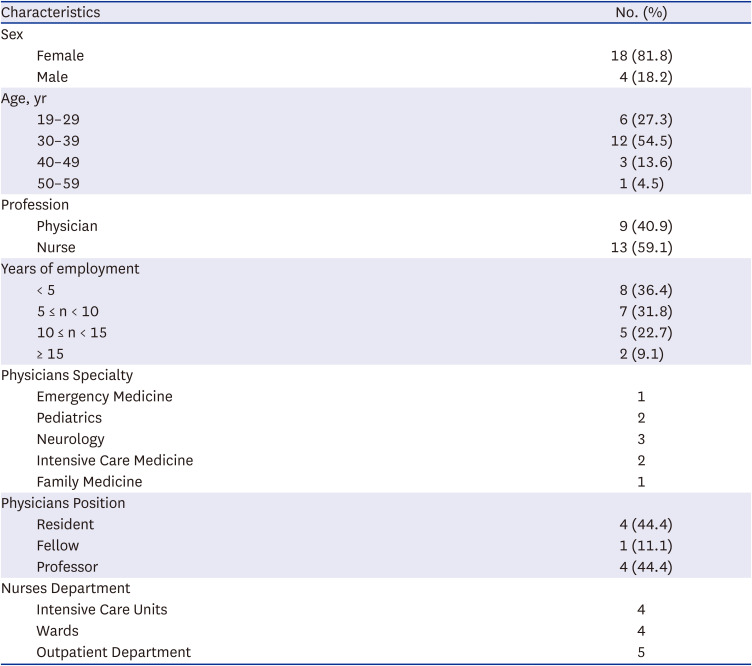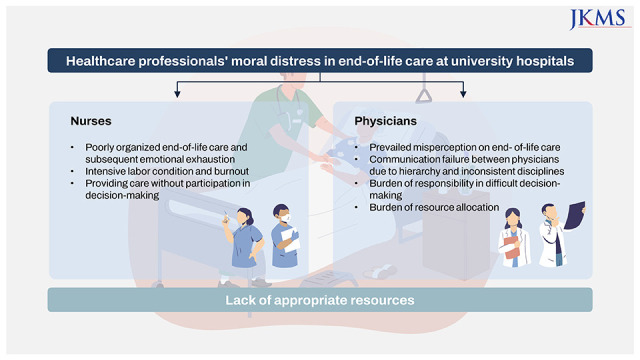1. Jameton A. Nursing Practice: The Ethical Issues. Englewood Cliffs, NJ, USA: Prentice-Hall;1984.
2. Kälvemark S, Höglund AT, Hansson MG, Westerholm P, Arnetz B. Living with conflicts-ethical dilemmas and moral distress in the health care system. Soc Sci Med. 2004; 58(6):1075–1084. PMID:
14723903.

3. Wilkinson JM. Moral distress in nursing practice: experience and effect. Nurs Forum. 1987; 23(1):16–29. PMID:
3454003.

4. Oh Y, Gastmans C. Moral distress experienced by nurses: a quantitative literature review. Nurs Ethics. 2015; 22(1):15–31. PMID:
24091351.
5. Bloomer MJ, Moss C, Cross WM. End-of-life care in acute hospitals: an integrative literature review. J Nurs Healthc Chronic Illn. 2011; 3(3):165–173.

6. Woo JA, Maytal G, Stern TA. Clinical challenges to the delivery of end-of-life care. Prim Care Companion J Clin Psychiatry. 2006; 8(6):367–372. PMID:
17245459.

7. Pauly BM, Varcoe C, Storch J. Framing the issues: moral distress in health care. HEC Forum. 2012; 24(1):1–11. PMID:
22446885.

8. Perni S. Moral distress: a call to action. AMA J Ethics. 2017; 19(6):533–536.

9. Moon JY, Lee HY, Lim CM, Koh Y. Medical residents’ perception and emotional stress on withdrawing life-sustaining therapy. Korean J Crit Care Med. 2012; 27(1):16–23.

10. Kang J, Choi EK, Seo M, Ahn GS, Park HY, Hong J, et al. Care for critically and terminally ill patients and moral distress of physicians and nurses in tertiary hospitals in South Korea: a qualitative study. PLoS One. 2021; 16(12):e0260343. PMID:
34914723.

11. Bernard HR. Research Methods in Anthropology: Qualitative and Quantitative Approaches. Lanham, MD, USA: Altamira Press;2006.
12. Patton MQ. Qualitative Research and Evaluation Methods: Integrating Theory and Practice. Thousand Oaks, CA, USA: Sage Publications;2014.
13. Strauss A, Corbin JM. Grounded Theory in Practice. Thousand Oaks, CA, USA: Sage;1997.
14. Hamric AB, Davis WS, Childress MD. Moral distress in health care professionals. Pharos Alpha Omega Alpha Honor Med Soc. 2006; 69(1):16–23.
15. Ulrich CM, Hamric AB, Grady C. Moral distress: a growing problem in the health professions? Hastings Cent Rep. 2010; 40(1):20–22.

16. Kim HR, Ahn SH. Moral sensitivity and moral distress among Korean hospital nurses. Korean J Med Ethics. 2010; 13(4):321–336.

17. Yoo MS. A study on the degree of moral distress of nurses in a city. J Korean Acad Nurs Adm. 2006; 12(1):131–139.
18. Han SJ. Relationship between moral distress and turnover intention among hospital nurses. J Korea Cont Assoc. 2012; 12(3):276–284.

19. Balaban RB. A physician’s guide to talking about end-of-life care. J Gen Intern Med. 2000; 15(3):195–200. PMID:
10718901.

20. Institute of Medicine. Approaching Death. Washington, D.C., USA: National Academies Press;1997.
21. Sullivan AM, Lakoma MD, Block SD. The status of medical education in end-of-life care: a national report. J Gen Intern Med. 2003; 18(9):685–695. PMID:
12950476.
22. Kang SY, Lee BS. The lived experience of nursing care for the dying patients in clinical nurses. J Korean Acad Nurs Adm. 2001; 7(2):237–251.
23. Huffman DM, Rittenmeyer L. How professional nurses working in hospital environments experience moral distress: a systematic review. Crit Care Nurs Clin North Am. 2012; 24(1):91–100. PMID:
22405714.

24. Choe K, Kang Y, Park Y. Moral distress in critical care nurses: a phenomenological study. J Adv Nurs. 2015; 71(7):1684–1693. PMID:
25688835.

25. Walker RM, Miles SH, Stocking CB, Siegler M. Physicians’ and nurses’ perceptions of ethics problems on general medical services. J Gen Intern Med. 1991; 6(5):424–429. PMID:
1744757.

26. Angell M. The doctor as double agent. Kennedy Inst Ethics J. 1993; 3(3):279–286. PMID:
10127995.

27. Levinsky NG. The doctor’s master. N Engl J Med. 1984; 311(24):1573–1575. PMID:
6438510.

28. Scheunemann LP, White DB. The ethics and reality of rationing in medicine. Chest. 2011; 140(6):1625–1632. PMID:
22147821.

29. Oberle K, Hughes D. Doctors’ and nurses’ perceptions of ethical problems in end-of-life decisions. J Adv Nurs. 2001; 33(6):707–715. PMID:
11298208.

30. Goethals S, Gastmans C, de Casterlé BD. Nurses’ ethical reasoning and behaviour: a literature review. Int J Nurs Stud. 2010; 47(5):635–650. PMID:
20096413.

31. Carse A, Rushton CH. Harnessing the promise of moral distress: a call for re-orientation. J Clin Ethics. 2017; 28(1):15–29. PMID:
28436924.

32. Epstein EG, Hurst AR. Looking at the positive side of moral distress: why it’s a problem. J Clin Ethics. 2017; 28(1):37–41. PMID:
28436927.

33. Epstein EG, Shah R, Marshall MF. Effect of a moral distress consultation service on moral distress, empowerment, and a healthy work environment. HEC Forum. 2023; 35(1):21–35. PMID:
33811568.



